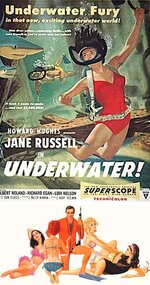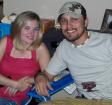Jimi D Pirate
Sr. Member
Florida treasures waiting to be found
* Stories of Florida treasures are dominated by accounts of buried pirate treasure and sunken Spanish galleons, both of which largely antedate indigenous American coinage. Undoubtedly there are more to be located. Nearly all finds have been associated with Spanish treasure fleet wrecks and not with pirates. The treasure-hunting community is particularly active along the Florida coast, and numerous shops offer Scuba equipment, electronic treasure detectors, guidebooks, and other useful items. Best to keep detectors out of any lease areas
* Fowler's Bluff on the Gulf Coast may be a productive site for the seeker of pirate treasure.
* At the headwaters of Carter's Mill Creek in the northern part of the state, My Stompin Grounds Indians may have cached a fortune in gold coins received from the British as payment for their depredations on settlers. I have done lots of research on this one, spent many moons in these woods and might add ... found many indian artifacts and chiggers!
* At Amelia Island there may be much buried pirate treasure. This is for IVAN
* F.L. Coffman reported that "an old treasure hunter, Bill Sneed," found $625,000 in gold bullion and coins at the mouth of the Suwanee River, a part of a treasure of gold coins valued at $5,000,000. The present writer knew Bill Sneed, who in the 1950s operated the Wilmary Motel in Lakeland, Florida, and recalls that he enjoyed regaling his acquaintances with tall tales, but had relatively few rare coins as evidence to verify his finds.
*Jose Gaspar, better known as Gasparilla the pirate , is said to have buried many treasures along the Gulf Coast. In modern times his name has been given to an annual festival in the Tampa-St. Petersburg area.
, is said to have buried many treasures along the Gulf Coast. In modern times his name has been given to an annual festival in the Tampa-St. Petersburg area.
*Near Fort Walton on Choctawhatchee Bay on the Gulf Coast, pirate Billy Bowlegs may have cached many gold and silver coins. OLD BOWLEGGED BILLY
OLD BOWLEGGED BILLY 
*On the bottom beneath the sparkling waters of Silver Springs, 72 degrees year round near Ocala, are coins tossed by tourists including, perhaps, some dating from the 1920s and 1930s or even earlier.
*In his History Under the Sea, 1965, I bet Kip read this one Mendel Peterson gave advice concerning potentially profitable sites for undersea treasure exploration, noting: "The reefs of the Florida Keys and coast of Florida north to Cape Kennedy [Cape Canaveral], which is one of the richest spots." Further: "Almost any bar lying near harbor approaches on the Atlantic coast will yield sites. On the eastern side of the Florida Passage to the Bahamas formed a dangerous barrier for ships, and these reefs and keys are littered with sites." I thought this was a native secret!
* Stories of Florida treasures are dominated by accounts of buried pirate treasure and sunken Spanish galleons, both of which largely antedate indigenous American coinage. Undoubtedly there are more to be located. Nearly all finds have been associated with Spanish treasure fleet wrecks and not with pirates. The treasure-hunting community is particularly active along the Florida coast, and numerous shops offer Scuba equipment, electronic treasure detectors, guidebooks, and other useful items. Best to keep detectors out of any lease areas
* Fowler's Bluff on the Gulf Coast may be a productive site for the seeker of pirate treasure.
* At the headwaters of Carter's Mill Creek in the northern part of the state, My Stompin Grounds Indians may have cached a fortune in gold coins received from the British as payment for their depredations on settlers. I have done lots of research on this one, spent many moons in these woods and might add ... found many indian artifacts and chiggers!
* At Amelia Island there may be much buried pirate treasure. This is for IVAN
* F.L. Coffman reported that "an old treasure hunter, Bill Sneed," found $625,000 in gold bullion and coins at the mouth of the Suwanee River, a part of a treasure of gold coins valued at $5,000,000. The present writer knew Bill Sneed, who in the 1950s operated the Wilmary Motel in Lakeland, Florida, and recalls that he enjoyed regaling his acquaintances with tall tales, but had relatively few rare coins as evidence to verify his finds.
*Jose Gaspar, better known as Gasparilla the pirate
*Near Fort Walton on Choctawhatchee Bay on the Gulf Coast, pirate Billy Bowlegs may have cached many gold and silver coins.
*On the bottom beneath the sparkling waters of Silver Springs, 72 degrees year round near Ocala, are coins tossed by tourists including, perhaps, some dating from the 1920s and 1930s or even earlier.
*In his History Under the Sea, 1965, I bet Kip read this one Mendel Peterson gave advice concerning potentially profitable sites for undersea treasure exploration, noting: "The reefs of the Florida Keys and coast of Florida north to Cape Kennedy [Cape Canaveral], which is one of the richest spots." Further: "Almost any bar lying near harbor approaches on the Atlantic coast will yield sites. On the eastern side of the Florida Passage to the Bahamas formed a dangerous barrier for ships, and these reefs and keys are littered with sites." I thought this was a native secret!




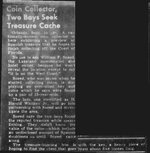
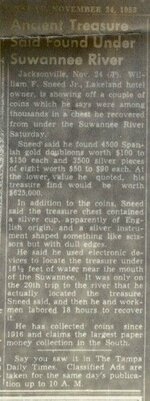
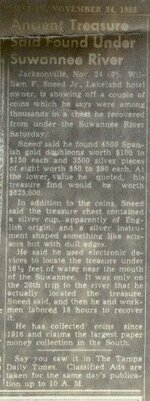
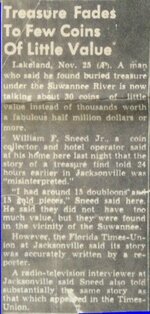
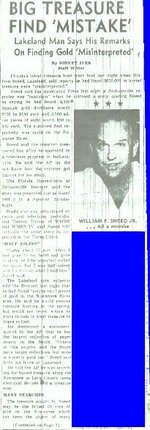
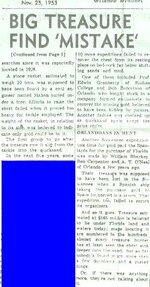

 . Go Noles!
. Go Noles!